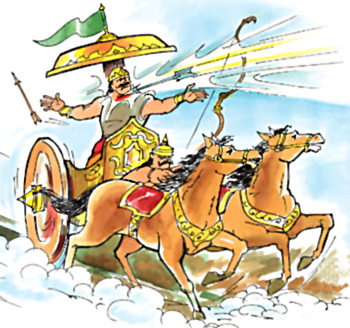 Lord Rama wounded himself by Indrajit who showered deadly arrows upon Rama and Lakshmana and himself remained invisible. After the whole of Lanka was besieged by the monkey host, the four rakshasa followers of Vibhishana had spied on Lanka, and knew the disposition of the forces of Ravana and Rama laid siege to the four gates of Lanka accordingly, establishing the monkey Nila at the eastern gate, guarded by the rakshasa general Prahasta and Angada at the western gate, guarded by Mahaparshwa. He put Hanuman at the southern gate, guarded by Prince Indrajit and he attacked the north gate which was guarded by Ravana.
Lord Rama wounded himself by Indrajit who showered deadly arrows upon Rama and Lakshmana and himself remained invisible. After the whole of Lanka was besieged by the monkey host, the four rakshasa followers of Vibhishana had spied on Lanka, and knew the disposition of the forces of Ravana and Rama laid siege to the four gates of Lanka accordingly, establishing the monkey Nila at the eastern gate, guarded by the rakshasa general Prahasta and Angada at the western gate, guarded by Mahaparshwa. He put Hanuman at the southern gate, guarded by Prince Indrajit and he attacked the north gate which was guarded by Ravana.
Rama sent Angada as an envoy to the palace of Ravana and challenged him to the fight. But Ravana, forgetting the respect due to an envoy, would have slain him; however Angada sprang away and broke the palace roof, and returned to Rama. After this the monkeys advanced in order and swarmed about the walls, flooding the moat and striking terror into the hearts of the rakshasas; scaling parties and climbing the walls and battering down the gates with trees and stones, and shouting for the victory for Rama and Sugriva.
The rakshasas sallied forth in return with a horrid trumpeting and joined in battle with the monkeys, and the atmosphere was filled with the noise of fighting, and terrible confusion arose of friend and foe and man and beast, and the earth was strewn with flesh and wet with gore. Thus an equal battle was fought till evening; but the rakshasas waited for the night, and thirstily desired the sunset, for night is the time of strongest might for the rakshasas. Once the night fell, the demons ranged, devouring monkeys by thousands.
Then those of the party of Rama rallied and for a time it prevailed, and Indrajit was beaten back. But Indrajit, the son of Ravana, resorting to his magic and became invisible, and directed deadly arrows upon Rama and Lakshmana; fighting in crooked ways, he bound the two brothers fast so that they fell helpless to the ground, covered with a thousand wounds. Hanuman, Sugriva, Vibhishana and all the leaders of the monkeys stood round the wounded Rama and Lakshmana with tear-filled eyes; but Indrajit, unseen of any except his uncle Vibhishana, rejoiced, and let fly numerous shafts that also wounded Nila, Jambavan and Hanuman. Then Indrajit returned victorious to Lanka and his father welcomed him and for a short period of time the fighting ceased.
Finding Rama and Lakshmana wounded, Vibhishana rallied the frightened monkeys, and comforted Sugriva by saying that the time was not appropriate for grieving for Rama was not dying. He thus asked Sugriva to gather the forces and inspire them with fresh hope. But the monkeys were panic-stricken, and with the movement of a straw they deemed it to be a rakshasa. By that time Ravana took Sita on his car and showed her that Rama and Lakshmana were lying on the field, senseless and pierced with several arrows, wounded and lying in the dust. Sita deemed them to be dead, and wailed, but Ravana took her back again to Lanka.
In due course, Rama came to sense and seeing Lakshmana seeming to be dead, he lamented tremendously, and praising what the monkeys had done, though unsuccessful, he requested them to go across the bridge and seek their homes. And Vibhishana, too, had no more taste for battle or wish for the throne of Lanka. Meanwhile, Sugriva comforted them and gave them fresh courage, and the monkey chief Sushena told of a magic herb that grows by the Milky Ocean, and can restore the dead to life. Thus, the wounding of Rama and Lakshmana by Indrajit has been described well in the Yuddha Kanda of Ramayana.












